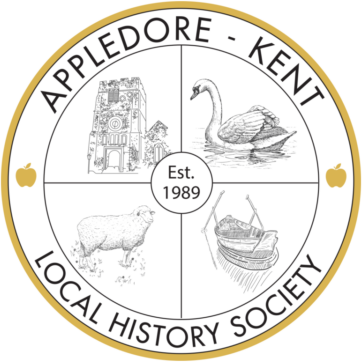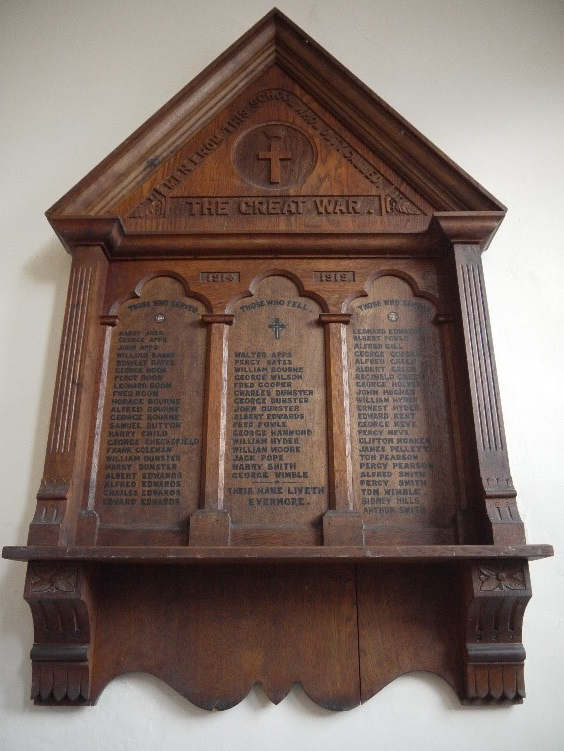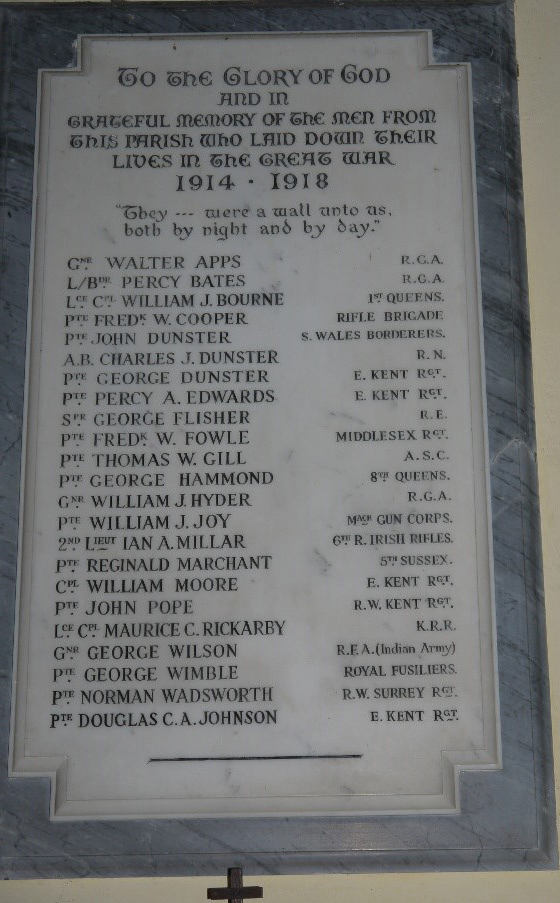Appledore, the two World Wars and some bits in between!
WW1 in Appledore is happily covered in depth by the fact that there is a Heritage Lottery funded trail here and this can be accessed here on this website.
The Roll of Honour was once hung in the Methodist Chapel, Appledore, lists 45 Appledore men who served and survived WW1 and 16 who sadly fell. This memorial is headed ‘Men from this School Whom Duty Called’ and it is thought that it was originally placed in Appledore School and so it may only relate to former pupils. Upon closure of the Methodist Chapel and its sale into private ownership the memorial was moved to St Peter’s & St Paul’s Church, Appledore.
The Roll of Honour in St Paul and St Peter Church, Appledore, lists another 9 men who fell, and in February 1915 in the Kentish Express there was a list of those serving from Appledore which named another 19 men, when Appledore’s population was 547, who are not named on either Roll of Honour;
Peace celebrations were as described in this excerpt from Kentish Express;
Of the men who served and survived (information mostly from Lives of WW1);
- George Addy was a farm labourer from Hornbrook Farm, Woodchurch.
- Harry Ames lived at Mill House, the house of Stephen Button, and was a farm labourer. Samuel Button was at school and also lived at Mill House.
- George and John Apps were brothers and their father was a farm labourer.
- William Banks was a House Boy and lived in Lower Heath. He was the son of William Banks, a Roadman.
- Stanley Bates lived at Canal Cottage and was a butcher and became a Royal Navy Seaman during WW1.
- George Boon was a farmer’s son and lived at Prospect House.
- Albert Percy Boon was also a farmer’s son, working on the farm. He lived with his wife and son at 2 Victoria Cottages.
- Leonard Boon was also a farmer’s son working on the farm at The Mill. Fred Boon was his brother and their father was Alfred Boon.
- Harry Child was a wagoner and lived on The Heath. He lived at the Holyer household, headed by William, a Road Forman.
- George Checksfield was a farm labourer in Court Lodge Road and his father was a wagoner on the farm. George joined the Buffs (5th) in WW1.
- Frank Coleman was a farm labourer and was married with a daughter.
- John Mac Cooper lived on Station Road and was a farm labourer.
- Alec Cowley lived in Court Lodge Road and was one of 9 children.
- William Edward Dunster was a farm labourer and lived at 1 New Rents.
- Harry Dunster, brother of William, was also a farm labourer. He joined the Labour Corps in 1916 and the East Surrey Regiment in 1919.
- Albert Fowle lodged, along with his brother, Frederick, a farm labourer, at the house of George Johnson in Court Lodge Road.
- Alfred Friend was a farm labourer.
- George Godden, a farm labourer, lived with his widowed mother.
- Alfred Green was a domestic gardener and lived with his parents. His father was a butcher.
- Sidney Hills was a postman.
- George Holyer was a farm labourer and lived on The Heath.
- John Hughes lived with the Coleman family, as they were his Uncle, Aunt and Cousin.
- William John Hyder was a farm labourer and lived at 2 West End Cottages. He joined the Royal Field Artillery in WW1.
- William Ernest Hyder lived with his parents in The Street.
- Edward Kent was a farm labourer and lived in The Street.
- John Henry Papworth King was an Army Pensioner, Station Keeper and his son, also John henry Papworth King was a farm labourer, living in The Street. 8 children in total.
- Victor George Neve, a farm labourer, and his brother, Percy, lived at Rose Cottages with their French father, who was a Journeyman Baker.
- Ewart Johnson was a house painter and lived in The Street. His brother, Douglas Claud Allen died during WW1.
- Clifton Noakes lived at The Red Lion Inn with his Grandfather, the Inn Keeper and his father, a farmer.
- James Pellett lived in The Street and was a Grocer’s Warehouseman. He joined the Army Service Corps.
- Tom and Percy Pearson lived at Wimble Cottage. There was a total of 7 children in the family and their father was a general labourer.
- Alfred, Percy and Arthur Smith lived at Mill House. Percy was a House Boy.
- James Percy Springett was an engine driver and lived at Pump House, Station Road.
- Richard Thomas Springett lived at Steam Mill Cottage and joined the Royal Horse and Field Artillery.
- Tom Wimble joined the Royal Garrison Artillery.
It would appear that the Edwards family; Albert, Alfred, Charles, Edward and Leonard was headed by their widowed mother, Mary Ann. Albert was a Railway Porter, Alfred was a farm labourer, Edward was a labourer at the Coal Yard and Leonard was at school.
Flight Lieutenant Arthur Thomas Wheatley – killed in action 01.03.1944 aged 22. He was an RAF Bomber Command pilot (service number 42290). F L Wheatley was the son of Anne Alleyne Wheatley, elder daughter of T J Pearson of Park House, Appledore. Little else is known about him at the present time, but there is a plaque on a wall in the church of St Peter and St Paul, separate from the commemorative roll of honour, which he does not appear on. We do know that he is buried in the Schoonselhof Cemetary, Belgium.
Click here to review the WW1 Memorial book created by Rev. Keith Fazzani and kindly donated to ALHS. (Please note this document is not downloadable)
Inbetween Years
We have a 1928 photo of some of them; Samuel Button, Frank Coleman and Tom Wimble, when part of the Appledore goal running team, with their trophies.
Frank Coleman was Best Man at the wedding of Mr CH Terry and Miss DM Bourne in 1937 (Kentish Express)) and is also mentioned as having been playing cricket at a match in 1928, along with others from our Roll of Honour lists; Clifton Noakes, Albert or Alfred Green, Albert or Alfred Edwards. (1928 Cricket match)
Clifton Noakes’ sister got married in 1930 and he gave her away as their parents had already died. (Clifton Noakes)
Mr Tucker became Superintendent of the Hythe Acoustical Section, built in around 1923 as an outpost of the Air Defence Research Establishment at Biggin Hill. Discs, masts and vimys, along with a good knowledge of Romney Marsh and the farming community, were used to test the ability to be ‘Kent’s Listening Ears’ for enemy aircraft.


